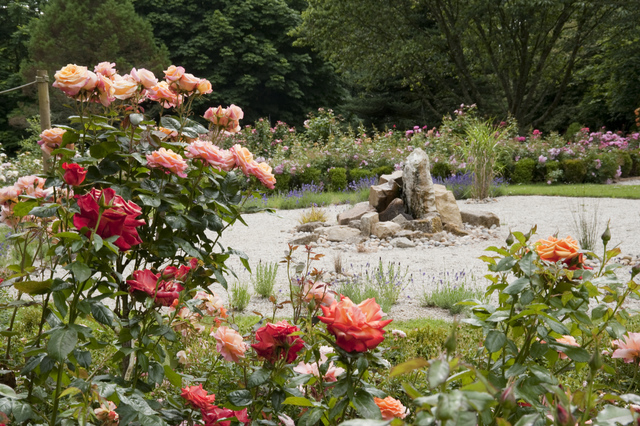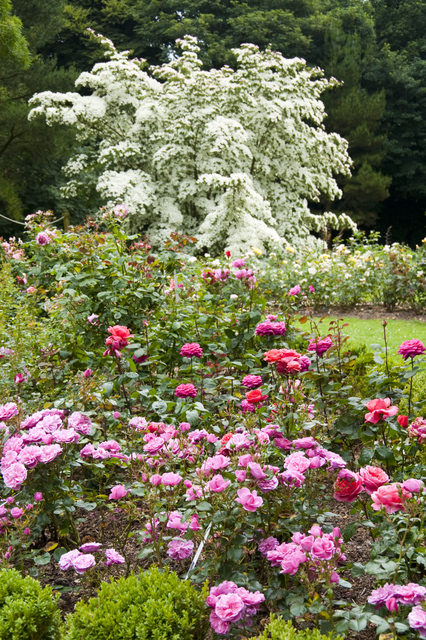
Concentric rose bed around the central rock fountain at Trewithen Rose Garden.
Photographs: Charles Francis
September 2009: Rows and rows of roses have made a magnificent multi-coloured patchwork this summer, in a field on the edge of a Cornish village. Yet in nearby supermarkets and garden centres, local people and holidaymakers are celebrating special occasions by growing roses grown in Africa and South America. They share a widespread belief that it is just not possible to grow roses successfully in Cornwall.
A partnership between one of the great gardens of Cornwall and one of the county’s newest nurseries is set to scotch this myth. The rose field at Mitchell is part of a 20-acre operation run by the Cornish Rose Company, and many of the varieties grown here by owners Stewart and Rebecca Pocock now grace the glorious rose garden at Trewithen.
“It was fate which brought us together,” says Gary Long, head gardener at Trewithen. “We wanted to create a rose garden, and Stewart wanted to work with a well-known rose-growing garden in Cornwall.”

Rosa ‘Bewitched’ in front of Cornus cousa
The project now coming to fruition at both Mitchell and Trewithen has deep roots. It was in the early 1990s that Stewart, who was running a nursery at Romsey in Hampshire, first decided to have a stand at the Royal Cornwall Show. “We had an abysmal show,” he remembers. “People kept saying: ‘You can’t grow roses in Cornwall!’.
“Four or five years later, the Royal Cornwall Show people persuaded us to come again. We said it would be a waste of time, but we had a reasonable response — and by the next year, we had some return customers, who said the roses had done really well. It got to the point where we were sending more roses to Cornwall than anywhere else in the UK. I did some research, and found that Cornwall was being very badly served. Varieties were being sent down which weren’t suitable for the climate.”
Stewart knew that he could offer a better service, so he and Rebecca searched for a suitable space to set up the Cornish Rose Company. The land at Mitchell was not windy or damp, but it had drawbacks, as Stewart explains: “It hadn’t been cultivated for three or four years, so it was chest-high in gorse bushes, ragwort and dock. We spent a year getting rid of the weeds and getting our first lot of roses in.”
Early results were encouraging — and then Stewart learned that Michael Galsworthy, owner of Trewithen, was planning to create a rose garden.
“We already had roses in our walled garden,” says Gary. “But Mr Galsworthy wanted to create the first dedicated rose garden open to the public in Cornwall. Trewithen is known for its springtime flowers, but the idea was to give the garden summer interest as well. “The design evolved from a central water feature, and the beds were planned and planted to give an outline of a Cornish cross. We dug them over and incorporated spent mushroom compost. There are white roses on the east side, going right around through pink and purple to hot colours in full sun. Box hedging formalises the area, and we also have lavender to give the added dimension of a scented circle.

Concentric rose beds around the central rock fountain at Trewithen
“Stewart did the planting scheme, as he’s the expert — it’s a learning curve for me. He selected varieties known to be disease-resistant. He also chose one of the oldest cultivars, Rosa mundi, which was hybridised in the 1700s, right up to new varieties like the pink shrub rose, ‘Gertrude Jekyll’, which is heavily scented, as is ‘Duchess of Cornwall’, a nice compact rose with really good showy flowers.”
The garden was planted in November 2007, and hopes were high for a stunning show last summer, but weeks of wet and windy weather meant that many buds withered and died before they could flower. However, this year’s winter frosts were followed by a mild spring, which blossomed into a sunny, warm May and June — perfect conditions for rose-growing. Visitors to Trewithen have been enchanted by the spectacular display.
